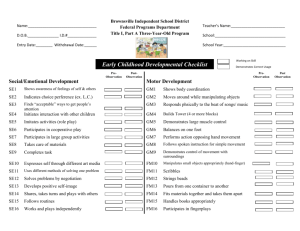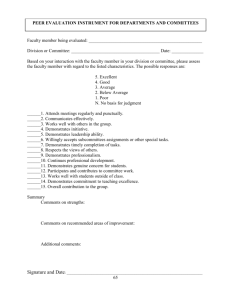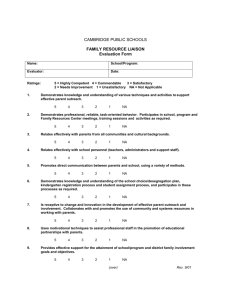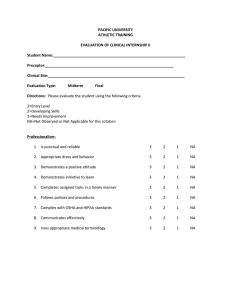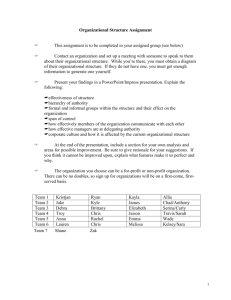UNIVERSITY OF SOUTH ALABAMA COLLEGE OF NURSING FOR PROMOTION NON-TENURE TRACK
advertisement
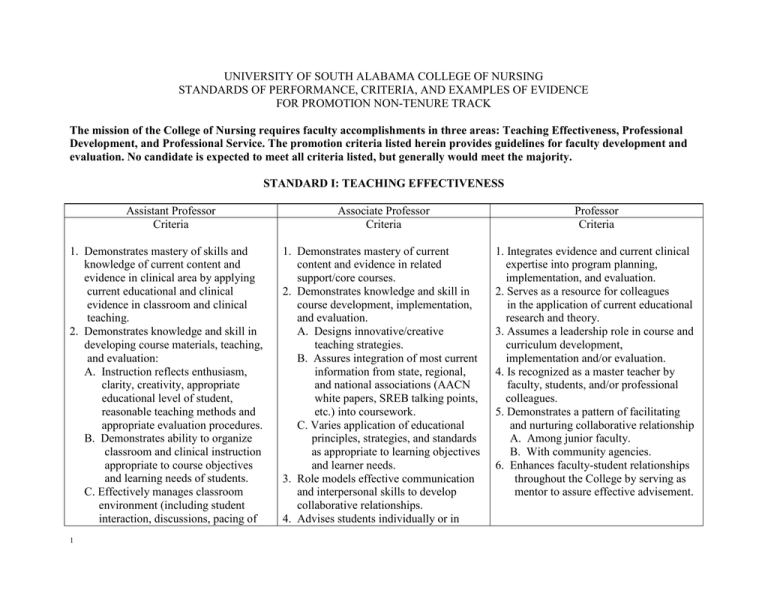
UNIVERSITY OF SOUTH ALABAMA COLLEGE OF NURSING STANDARDS OF PERFORMANCE, CRITERIA, AND EXAMPLES OF EVIDENCE FOR PROMOTION NON-TENURE TRACK The mission of the College of Nursing requires faculty accomplishments in three areas: Teaching Effectiveness, Professional Development, and Professional Service. The promotion criteria listed herein provides guidelines for faculty development and evaluation. No candidate is expected to meet all criteria listed, but generally would meet the majority. STANDARD I: TEACHING EFFECTIVENESS Assistant Professor Criteria 1. Demonstrates mastery of skills and knowledge of current content and evidence in clinical area by applying current educational and clinical evidence in classroom and clinical teaching. 2. Demonstrates knowledge and skill in developing course materials, teaching, and evaluation: A. Instruction reflects enthusiasm, clarity, creativity, appropriate educational level of student, reasonable teaching methods and appropriate evaluation procedures. B. Demonstrates ability to organize classroom and clinical instruction appropriate to course objectives and learning needs of students. C. Effectively manages classroom environment (including student interaction, discussions, pacing of 1 Associate Professor Criteria Professor Criteria 1. Demonstrates mastery of current content and evidence in related support/core courses. 2. Demonstrates knowledge and skill in course development, implementation, and evaluation. A. Designs innovative/creative teaching strategies. B. Assures integration of most current information from state, regional, and national associations (AACN white papers, SREB talking points, etc.) into coursework. C. Varies application of educational principles, strategies, and standards as appropriate to learning objectives and learner needs. 3. Role models effective communication and interpersonal skills to develop collaborative relationships. 4. Advises students individually or in 1. Integrates evidence and current clinical expertise into program planning, implementation, and evaluation. 2. Serves as a resource for colleagues in the application of current educational research and theory. 3. Assumes a leadership role in course and curriculum development, implementation and/or evaluation. 4. Is recognized as a master teacher by faculty, students, and/or professional colleagues. 5. Demonstrates a pattern of facilitating and nurturing collaborative relationship A. Among junior faculty. B. With community agencies. 6. Enhances faculty-student relationships throughout the College by serving as mentor to assure effective advisement. instruction, etc). 3. Demonstrates effective communication and interpersonal skills to develop collaborative relationships within the College and other settings. 4. Establishes a caring environment in classroom, clinical and student advising. Examples of Evidence 1. Specialty theory clinical course evaluations. 2. Clinical agency evaluations. 3. Course and/or curriculum development information. 4. Evidence of course development, activity development, etc. 5. Demonstration of innovative, creative teaching strategies. 6. Active participation in course workgroups. 7. Annual performance appraisal. 8. Certification (when available) in area of specialization. 2 groups to enhance success in the program. Examples of Evidence 1. Teacher evaluations in core/support courses. 2. Demonstrates leadership in course development, implementation and evaluation. 3. Integrates evidence from research and theories into curriculum and course related activities. 4. Guides less experienced faculty in use of teaching strategies, course development, implementation and evaluation. 5. Designs, tests and evaluates innovative teaching strategies. 6. Recognized as a master teacher. 7. Demonstrates beginning success in extramural funding. 8. Membership on key college committees such as curriculum, evaluation, admission and progression, etc. 9. Maintains certification in area of specialization (when available). Examples of Evidence 1. Chairs College committees such as Curriculum, Evaluation, Admission and Progression, etc. 2. Assumes a leadership role in program planning, implementation, and evaluation. 3. Synthesizes educational research and theories and tests and evaluates innovative teaching strategies for integration into the curriculum and/or professional continuing education. 4. Serves as a faculty mentor 5. Recognized regionally or nationally for expertise. UNIVERSITY OF SOUTH ALABAMA COLLEGE OF NURSING STANDARDS OF PERFORMANCE, CRITERIA, AND EXAMPLES OF EVIDENCE FOR PROMOTION NON-TENURE TRACK STANDARD II: PROFESSIONAL DEVELOPMENT Assistant Professor Criteria 1. Participates in clinical scholarship (individual or team) 2. Uses evidence as a foundation for practice. 3. Integrates current evidence into curriculum and course-related activities. 4. Disseminates scholarly work at local and state levels. 5. Submits manuscripts to peer-reviewed publications. Examples of Evidence 1. Collaborator on clinical projects. 2. Recipient of Small grant funding for clinical scholarship. 3. Poster or podium presentations; electronic dissemination. 4. Publication of peer-review articles, chapters, or books. 3 Associate Professor Criteria Professor Criteria 1. Consistent involvement in scholarly Projects (individual or team). 2. Demonstrates a pattern of scholarship (regional, national, or international). 3. Develops substantive expertise of importance to nursing. 4. Mentors or coaches others in practice excellence. 1. Leads grant team for extramurally funded projects. 2. Demonstrates a focused, sustained, productive program of clinical leadership. 3. Leads agency in clinical scholarship. 4. Recognized beyond Alabama for expertise. Examples of Evidence 1. Project director or associate director of clinical or extramural funding projects 2. Peer-reviewed articles, chapters, books, and/or web-resources. 3. Peer reviewer for journal; invited presentations; consultation; work is cited by other scholars. 4. Graduate student project committee member. Examples of Evidence 1. Project Director or Associate Project Director of grants 2. Scholarly papers, data-based manuscripts in refereed journals; regional, national, or international presentation or web-resources. 3. Editorial board member, journal reviewer, graduate student project committee member or chair; policy board member. 4. Awards, consulting, citations by other scholars and leaders in the profession. UNIVERSITY OF SOUTH ALABAMA COLLEGE OF NURSING STANDARDS OF PERFORMANCE, CRITERIA, AND EXAMPLES OF EVIDENCE FOR PROMOTION NON-TENURE TRACK STANDARD III: PROFESSIONAL SERVICE Assistant Professor Criteria 1. Participates in CON and University governance. 2. Participates in extracurricular student organizations/activities. 3. Contributes to community service in one or more areas. 4. Participates in professional organizations. Associate Professor Criteria Professor Criteria 1. Demonstrates leadership on CON committees. 2. Regularly attends University and/or Ad Hoc committees. 3. Demonstrates leadership and professional involvement in: A. Professional organizations B. Organizations that effect change in health care, nursing, or education. 1. Demonstrates leadership on CON and University committees. 2. Demonstrates expanded leadership in: A. Professional organizations (local, state, or national and/or international) B. University-related community service activities, e.g.: a) Serve on Board of Directors b) Provide CE programs c) Provide professional consultation or expert testimony d) Provide direct health care Examples of Evidence Examples of Evidence 1. Participates in continuing education. 2. Regularly attends committees as assigned 3. Contributes to professional organizations/community agencies; serves on Advisory Boards, etc. 4. Participates in organizational activities: A. Convocation. B. Graduation. C. SNA activities. D. Career guidance to high schools. E. Advising 5. Participates in faculty practice. 4 1. Chairs one or more CON committees. 2. Serve on Advisory Board(s). 3. Provide CE programs 4. Provide/supervise/contribute to health-related projects. 5. Integrates service activities into CON curriculum 6. Mentors less experienced faculty in service related activities/opportunities. 7. Assumes leadership role as part of faculty practice. Examples of Evidence 1. Service role at local, state, national, international levels by achieving: A. Recognition for faculty practice. B. Leadership in health care activities: a) Advisory Board/BOD b) CE program presentation 2. Mentors faculty in service areas. 3. Actively contributes to CON or University governance 4. Sustained faculty practice 5
